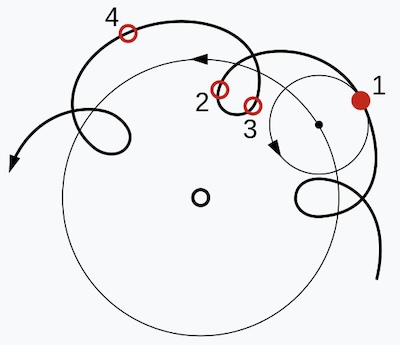A Better Leap Year
Tagged:Beauty
/
Math
/
Obscurantism
/
TheDivineMadness
/
ϜΤΦ
So, it’s Leap Year Day. Is the Gregorian calendar we use in any sense optimal?
Why Leap Years?
 The thing is, the mean solar year, determined astronomically, is 365.2421897 days. It may
perhaps come to your attention that this is not an integer. This is because there is no
particular reason the earth should rotate on its axis an integer number of times during
the time it goes once around the sun. These are celestial bodies, not gears (Hipparchus,
Ptolemy and their epicycles and deferents
notwithstanding!).
The thing is, the mean solar year, determined astronomically, is 365.2421897 days. It may
perhaps come to your attention that this is not an integer. This is because there is no
particular reason the earth should rotate on its axis an integer number of times during
the time it goes once around the sun. These are celestial bodies, not gears (Hipparchus,
Ptolemy and their epicycles and deferents
notwithstanding!).
Why should we care?
Consider your average Neolithic farmer in northern Europe. The growing season is short, and the ancestral grain strains didn’t grow as fast as modern ones. If you plant to early, your crops freeze and die. If you plant too late, fall comes before maturity and your crops freeze and die. Shortly after that, you and everyone you know and love will starve and die, since you had no harvest.
So it becomes a matter of some urgency to grab your local priest by the scruff of the neck, shake extra hard, and demand: “What day is it?!”
Something similar happened in ancient Egypt, where predicting when the Nile would flood was the thing you needed to know to avoid starvation (though probably not freezing).
(In the New World, things were a bit different. The Mayans and Aztecs, for example, still had to predict when the rainy season would come. They had rather more complex kinds of calendars, involving both a 260 day and 365 day calendar with big stone sculptures that could be rotated like gears. They’re doing … well, something interesting… but also something else, so we’ll save them for another time.)
So you need an accurate calendar not just for religious observations by priests, and not just for fuss-budget astronomy nerds, but also to know when to plant crops so you don’t die.
Some Calendars from Mediterranean Antiquity and Europe
The Egyptians figured out the length of the year and could time the Nile floods, so everybody could raise grain successfully. Their polytheistic religious system assigned lots of political and economic functions to different gods, but it more or less worked. Eventually, they figured out their calendar was a bit off, and so Egyptians introduced a leap day every 4 years. There were interactions with a lunar calendar, but it was mostly solar.
The Romans inherited this. [1] The Roman kalends were primarily solar. Indeed, my favorite way to say “when Hell freezes over” [2] is to mutter ad Kalendas Graecas, i.e., “when the Greeks count time by the kalends”, or pretty much never.
Alas, Roman politicians – much like the modern species – couldn’t resist monkeying about with the calendar to lengthen the terms of office of their friends and shorten those of their enemies.
Eventually Gaius Julius Caesar in 45BCE stepped in and said, “My dudes! No more kalends monkey-business. Years are now 365 days and every 4th year we add one more day to Februarius. Anybody who disagrees gets stabbed.” (Ok, maybe he didn’t say the stabbed thing out loud. But when the dux imperator speaks, the stabby bit is taken as read.)
That gets us the Julian calendar, with a mean year length (averaged over the 4 year period) of 365.25 days.
Why is That Not Good Enough?
Well, it’s mostly good enough to be getting on with… for a while.
The true length of the year is 365.2421897 days. So we’re overestimating the true length of each year by:
365.25days−365.2421897days=0.0078103days=674.81sec… or about 11 minutes and change each year. In about 128 years, we’ll be off by a whole day. In about 896 years, we’ll be off by a week. If you plant your crops in northern Europe a week off from the correct time, you’re at the edge where your crops will fail and… wait for it… you and everyone you know and love will starve and die.
And so it was in the year 1582CE. That’s 1582 + 45 = 1627 years from the start of the Julian calendar, so we’re off by 12.71 days. People are planting crops too late in the year to get a good harvest!
Something had to be done, and in the system of that time Pope Gregory XIII apparently felt he was the one to do it. He convened some scholars, who labored mightily and gave birth to the Gregorian calendar. This is still our calendar, in which a year is 365 days with sometimes 1 extra day for a leap year:
- Normally a year is not a leap year,
- Unless it’s divisible by 4, in which case it is,
- Unless it’s divisible by 100, in which case it’s not,
- Unless it’s divisible by 400, in which case it is.
It set the calendar 10 days forward, to re-establish the spring equinox for planting and Easter calculations, so that Thursday 4 October 1582 was followed by Friday 15 October 1582.
This bit of whimsical gimcrackery leads to a year length of:
365days+14day−1100day+1400day=365+97400days=365.2425daysSo now each year we’re off a bit, over estimating the length of the year by:
365.2425days−365.2421897days=0.0003103days=26.81secThat means the Gregorian calendar has reduced the error rate per year with respect to the Julian calendar by a factor of 674.81 sec / 26.81 sec = 25.71! That’s pretty impressive: if the Julian calendar got into trouble in just under 1,000 years then the Gregorian calendar will avoid similar trouble for maybe 25,000 years.
Can We Do Better?
Most people would say “good enough” and move on. But for those of us in the Nerd Tribe, well… we want to know what’s optimal, i.e., what’s the best we could do.
I first encountered this analysis in a post by Adam P Goucher, on the venerable Math-Fun mailing list, back in the day. [3]
If you look at the above equations, it’s pretty easy to intuit that any set of rules about what years include or do not include a leap day will result in a rational number of days; we could have written the rational version above and stopped there:
365days+14day−1100day+1400day=365+97400daysSo what’s the “best” rational approximation to the mean solar year length? “Best” needs some technical definition, since for a rational of arbitrarily large denominator we can make arbitrarily accurate approximations. So pretty much what we mean here is smallest error for a given number of digits in the denominator (or smaller, after dividing out common factors).
We observe the year length is 365.2421897 days, but the rest is some real number with unobserved decimal places out the wazoo. We could convert that finite decimal to a rational, observe 0 error, and be done. But can we do it with a smaller denominator?
Dirichlet’s Approximation Theorem says (approximately) the best approximation to a real number by a rational with a given size of denominator is the one we get by unwinding a continued fraction. (Yes, I could look up the details; no, I will not.)
The continued fraction is (by standard methods which again, I could exhibit, but won’t because it’s tedious to explain):
365.2421897=365+14+17+11+13+127+⋯The 5th continuand is 27, which is rather larger than its predecessors. This is a clue to truncate just before that, since the corrections will be tiny. This gives us the 4th convergent of:
365+14+17+11+13=365+31128=365+14−1128=365.2421875This gives us an error each year (under estimation, this time) of only a fraction of a second per year!
365.2421897days−365.2421875days=0.0000022days=0.19secThis system gives us a calendar in which a year is 365 days, with 1 extra day for a leap year, and the following leap year rules:
- Normally a year is not a leap year,
- Unless it’s divisible by 4, in which case it is,
- Unless it’s divisible by 128, in which case it’s not.
The next year in which this calendar differs from the present Gregorian calendar is 2048 = 128 * 16.
This rule system is simpler than the Gregorian (3 rules instead of 4) and has a shorter period (128 years instead of 400), and is about 141 times more accurate (0.19 sec/yr vs 26.81 sec/yr).
Also, the decision points (every 4 years and 128 years) are powers of 2, so in the Nerd Tribe where we do mental arithmetic in binary, all is simple. [4]
A Worst Case
Goucher goes on to explore the nightmare of a sadistic deity who wants to make it hard to determine when a leap year occurs. The mean year length would be 365+Φ days, where Φ=(√5+1)/2=1.618033⋯ is the Golden Ratio.
Φ has a continued fraction of all 1’s, so it converges slowly with no natural cutoff point. The sequence of leap years would be the Golden String, closely related to Fibonacci numbers.
The Weekend Conclusion
Yes, we can do better than the Gregorian calendar.
No, we almost certainly will not.
(Ceterum censeo, Trump incarcerandam esse.)
Notes & References
1: The Greeks went their own way with a calendar of 12 lunar months and an intercalary period at the end of the year to patch things up. It was a mess the Romans declined to continue. ↩
 2: That whispering sound you hear is the ghost of Dante Alighieri, who heard the phrase “when Hell freezes over”, would like a word with you about the center of Hell in his Inferno. In his vision, the center of Hell was a vast frozen lake, Cocytus, into which people were frozen in various horrible ways.
2: That whispering sound you hear is the ghost of Dante Alighieri, who heard the phrase “when Hell freezes over”, would like a word with you about the center of Hell in his Inferno. In his vision, the center of Hell was a vast frozen lake, Cocytus, into which people were frozen in various horrible ways.
So feel free to tell that Dante voice in your head to shut up and come back at a more semantically appropriate time. ↩
3: AP Goucher, “Calendars and continued fractions”, Math-Fun mailing list, 2011-Jan-25. ↩
4: Yes, I am aware that I am not quite making the case to the non-members of the Nerd Tribe, here. ↩

Gestae Commentaria
Comments for this post are closed pending repair of the comment system, but the Email/Twitter/Mastodon icons at page-top always work.